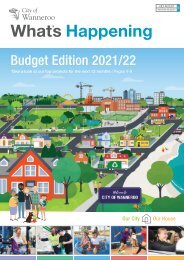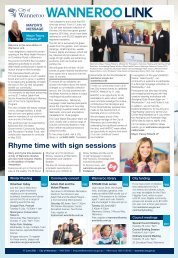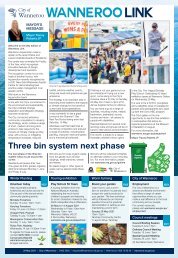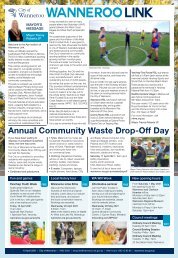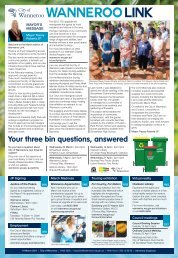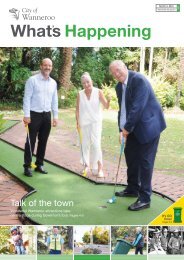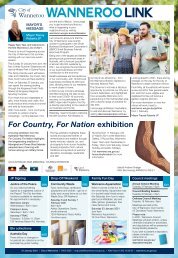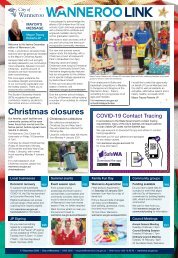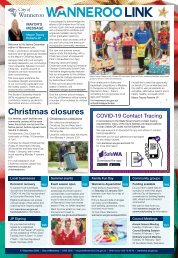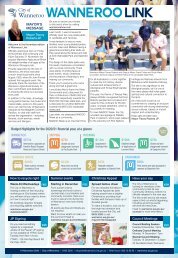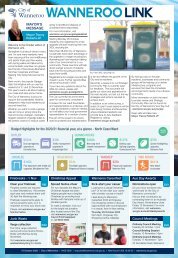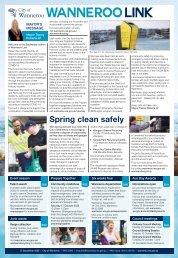Create successful ePaper yourself
Turn your PDF publications into a flip-book with our unique Google optimized e-Paper software.
Financial Statements 20<strong>15</strong><br />
City of Wanneroo<br />
Notes to the Financial Statements<br />
for the year ended 30 June 20<strong>15</strong><br />
Note 1. Summary of Significant Accounting Policies (continued)<br />
discounts estimated future cash payments or<br />
receipts (including fees, transaction costs and other<br />
premiums of discounts) through the expected life (or<br />
when this cannot be reliably predicted, the<br />
contractual term of the financial instrument to the net<br />
carrying amount of the financial asset or financial<br />
liability). Revisions to expected future cash flows will<br />
necessitate an adjustment to the carrying value with<br />
a consequential recognition of an income or expense<br />
in profit or loss.<br />
(i)<br />
Financial assets at fair value through<br />
profit or loss<br />
Financial assets at fair value through profit or loss<br />
are financial assets held for trading. A financial asset<br />
is classified in this category if acquired principally for<br />
the purpose of selling in the short term. Derivatives<br />
are classified as held for trading unless they are<br />
designated as hedges. Assets in this category are<br />
classified as current assets.<br />
(ii)<br />
Loans and receivables<br />
Loans and receivables are non-derivative financial<br />
assets with fixed or determinable payments that are<br />
not quoted in an active market. They are included in<br />
current assets, except for those with maturities<br />
greater than 12 months after the Statement of<br />
Financial Position date which are classified as noncurrent<br />
assets. Loans and receivables are included<br />
in trade and other receivables in the Statement of<br />
Financial Position.<br />
(iii)<br />
Held-to-maturity investments<br />
Held-to-maturity investments are non-derivative<br />
financial assets with fixed or determinable payments<br />
and fixed maturities that the City's management has<br />
the positive intention and ability to hold to maturity.<br />
If the City were to sell other than an insignificant<br />
amount of held-to-maturity financial assets, the<br />
whole category would be tainted and reclassified as<br />
available-for-sale. Held-to-maturity financial assets<br />
are included in non-current assets, except for those<br />
with maturities less than 12 months from the<br />
reporting date, which are classified as current<br />
assets.<br />
(iv)<br />
Available-for-sale financial assets<br />
or not classified in any of the other categories. They<br />
are included in non-current assets unless<br />
management intents to dispose of the investment<br />
within 12 months of the Statement of Financial<br />
Position date. Investments are designated as<br />
available-for-sale if they do not have fixed maturities<br />
and fixed or determinable payments and management<br />
intends to hold them for the medium to long term.<br />
(v)<br />
Financial Liabilities<br />
Non-derivative financial liabilities (excluding financial<br />
guarantees) are subsequently measured at amortised<br />
cost.<br />
Impairment<br />
At the end of each reporting period, the City assesses<br />
whether there is objective evidence that a financial<br />
instrument has been impaired. In the case of<br />
available-for-sale financial instruments, a prolonged<br />
decline in the value of the instrument is considered to<br />
determine whether impairment has arisen.<br />
Impairment losses recognised in the Statement of<br />
Comprehensive Income.<br />
(j)<br />
Fair Value Estimation<br />
The fair value of financial assets and financial<br />
liabilities must be estimated for recognition and<br />
measurement or for disclosure purposes.<br />
The fair value of financial instruments traded in active<br />
markets is determined using valuation techniques.<br />
The City uses a variety of methods and makes<br />
assumptions that are based on market conditions<br />
existing at each balance date. Quoted market prices<br />
or dealer quotes for similar instruments are used for<br />
long-term debt instruments held. Other techniques,<br />
such as estimated discounted cash flows, are used to<br />
determine fair value for the remaining financial<br />
instruments.<br />
The nominal value less estimated credit adjustments<br />
of trade receivables and payables are assumed to<br />
approximate their fair values. The fair value of<br />
financial liabilities for disclosure purposes is estimated<br />
by discounting the future contractual cash flows at the<br />
current market interest rate that is available to the City<br />
for similar financial instruments.<br />
Available-for-sale financial assets, comprising<br />
principally marketable equity securities, are nonderivatives<br />
that are either designated in this category<br />
page 16<br />
| ANNUAL REPORT <strong>2014</strong>/20<strong>15</strong> | CITY OF WANNEROO | FINANCIAL REPORT<br />
<strong>15</strong>3





